KB7038: Building Information Modeling Project, University Name
VerifiedAdded on 2023/01/19
|7
|1894
|99
Project
AI Summary
This project explores Building Information Modeling (BIM), a process supported by tools and techniques for managing digital representations of buildings. It details the stages of BIM implementation, including strategic definition, concept design, and construction, highlighting how BIM improves design, efficiency, and cost-effectiveness. The scope of BIM encompasses faster information sharing, better design through simulations, and improved customer services. The project also addresses the problems associated with BIM adoption, such as client demands, relevancy, and cost. The conclusion emphasizes BIM's role in construction, improved visualization, productivity, and cost reduction, along with its ability to contain data for building performance analysis. The document also includes references to various research papers related to BIM.
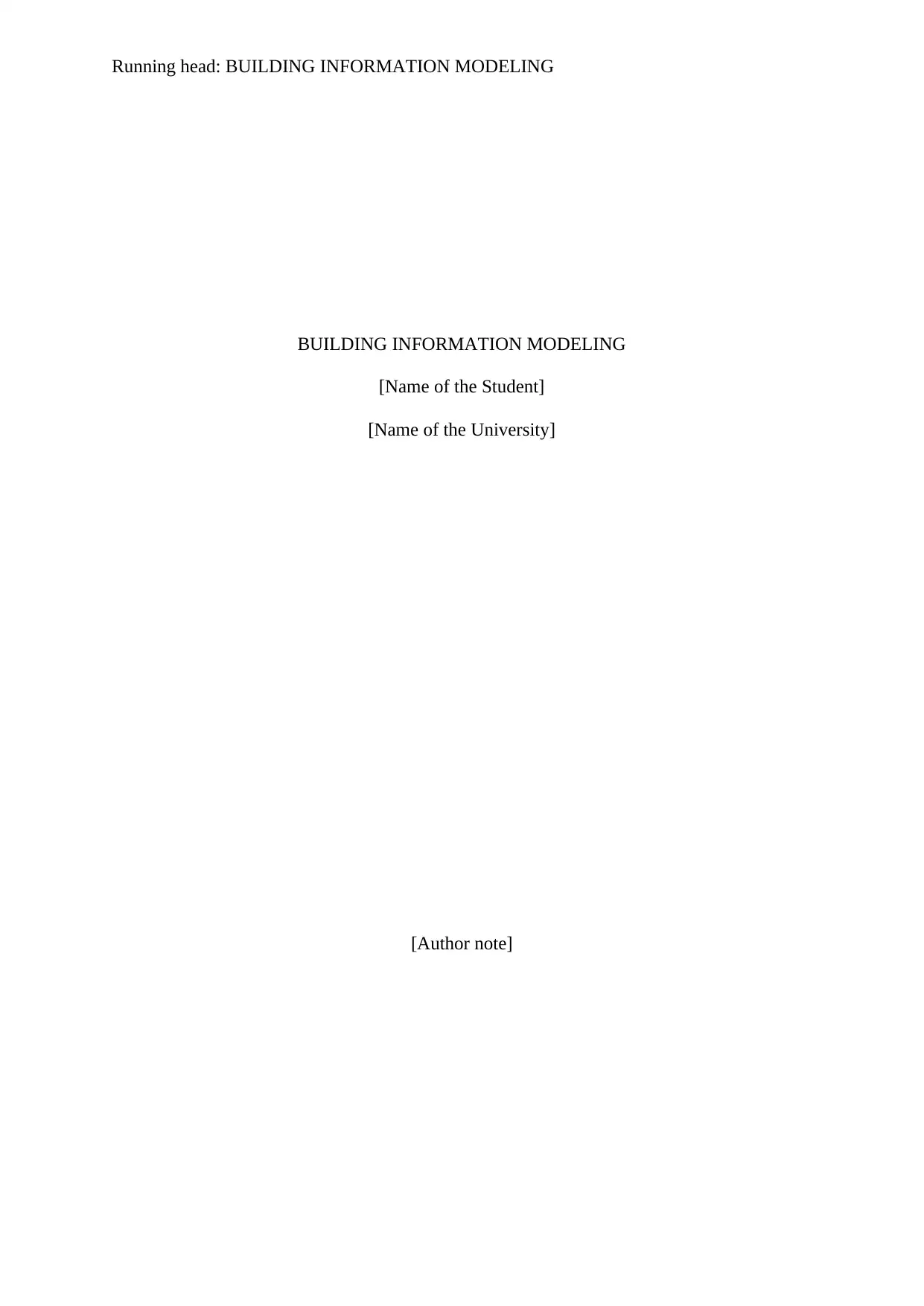
Running head: BUILDING INFORMATION MODELING
BUILDING INFORMATION MODELING
[Name of the Student]
[Name of the University]
[Author note]
BUILDING INFORMATION MODELING
[Name of the Student]
[Name of the University]
[Author note]
Paraphrase This Document
Need a fresh take? Get an instant paraphrase of this document with our AI Paraphraser
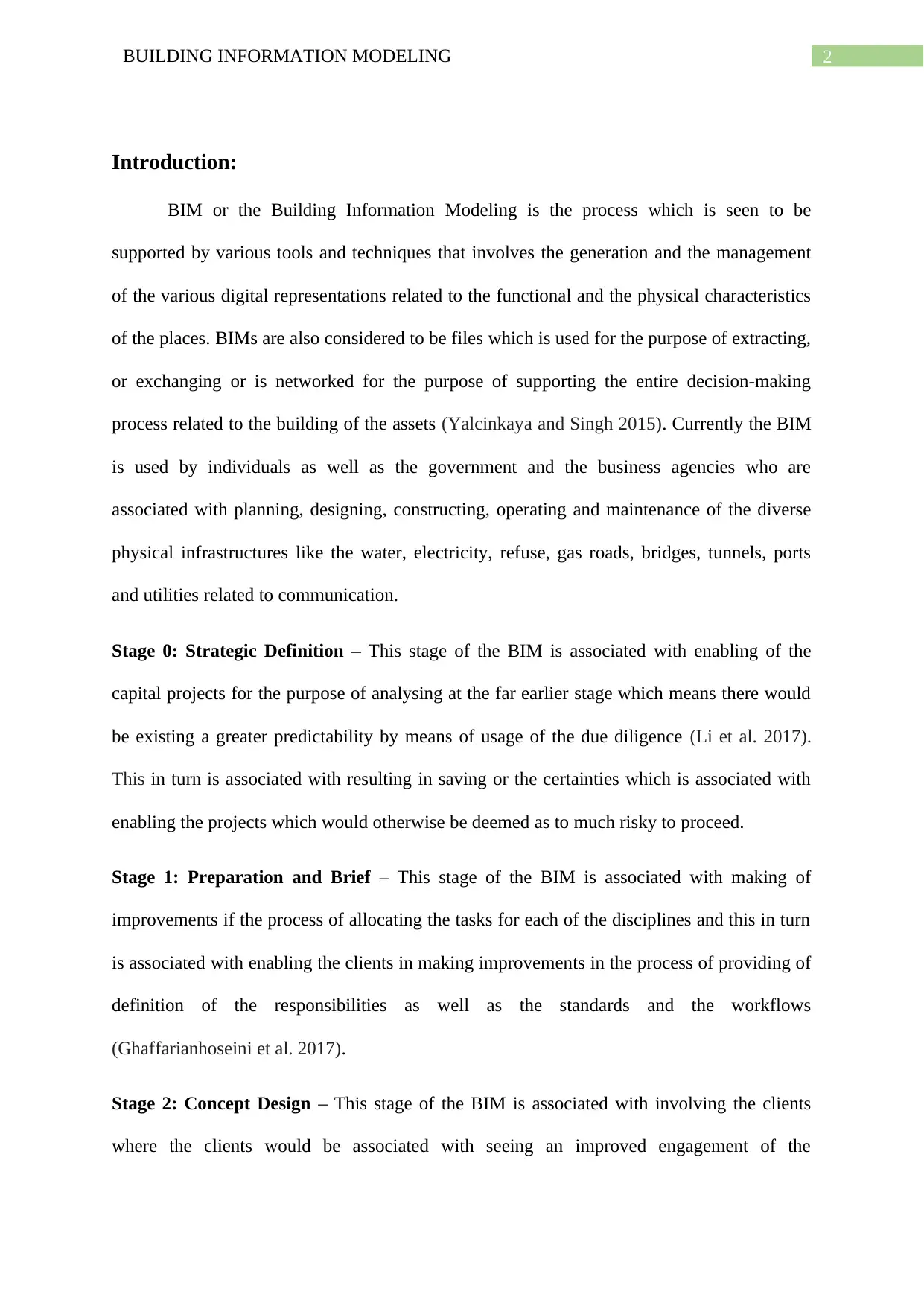
2BUILDING INFORMATION MODELING
Introduction:
BIM or the Building Information Modeling is the process which is seen to be
supported by various tools and techniques that involves the generation and the management
of the various digital representations related to the functional and the physical characteristics
of the places. BIMs are also considered to be files which is used for the purpose of extracting,
or exchanging or is networked for the purpose of supporting the entire decision-making
process related to the building of the assets (Yalcinkaya and Singh 2015). Currently the BIM
is used by individuals as well as the government and the business agencies who are
associated with planning, designing, constructing, operating and maintenance of the diverse
physical infrastructures like the water, electricity, refuse, gas roads, bridges, tunnels, ports
and utilities related to communication.
Stage 0: Strategic Definition – This stage of the BIM is associated with enabling of the
capital projects for the purpose of analysing at the far earlier stage which means there would
be existing a greater predictability by means of usage of the due diligence (Li et al. 2017).
This in turn is associated with resulting in saving or the certainties which is associated with
enabling the projects which would otherwise be deemed as to much risky to proceed.
Stage 1: Preparation and Brief – This stage of the BIM is associated with making of
improvements if the process of allocating the tasks for each of the disciplines and this in turn
is associated with enabling the clients in making improvements in the process of providing of
definition of the responsibilities as well as the standards and the workflows
(Ghaffarianhoseini et al. 2017).
Stage 2: Concept Design – This stage of the BIM is associated with involving the clients
where the clients would be associated with seeing an improved engagement of the
Introduction:
BIM or the Building Information Modeling is the process which is seen to be
supported by various tools and techniques that involves the generation and the management
of the various digital representations related to the functional and the physical characteristics
of the places. BIMs are also considered to be files which is used for the purpose of extracting,
or exchanging or is networked for the purpose of supporting the entire decision-making
process related to the building of the assets (Yalcinkaya and Singh 2015). Currently the BIM
is used by individuals as well as the government and the business agencies who are
associated with planning, designing, constructing, operating and maintenance of the diverse
physical infrastructures like the water, electricity, refuse, gas roads, bridges, tunnels, ports
and utilities related to communication.
Stage 0: Strategic Definition – This stage of the BIM is associated with enabling of the
capital projects for the purpose of analysing at the far earlier stage which means there would
be existing a greater predictability by means of usage of the due diligence (Li et al. 2017).
This in turn is associated with resulting in saving or the certainties which is associated with
enabling the projects which would otherwise be deemed as to much risky to proceed.
Stage 1: Preparation and Brief – This stage of the BIM is associated with making of
improvements if the process of allocating the tasks for each of the disciplines and this in turn
is associated with enabling the clients in making improvements in the process of providing of
definition of the responsibilities as well as the standards and the workflows
(Ghaffarianhoseini et al. 2017).
Stage 2: Concept Design – This stage of the BIM is associated with involving the clients
where the clients would be associated with seeing an improved engagement of the
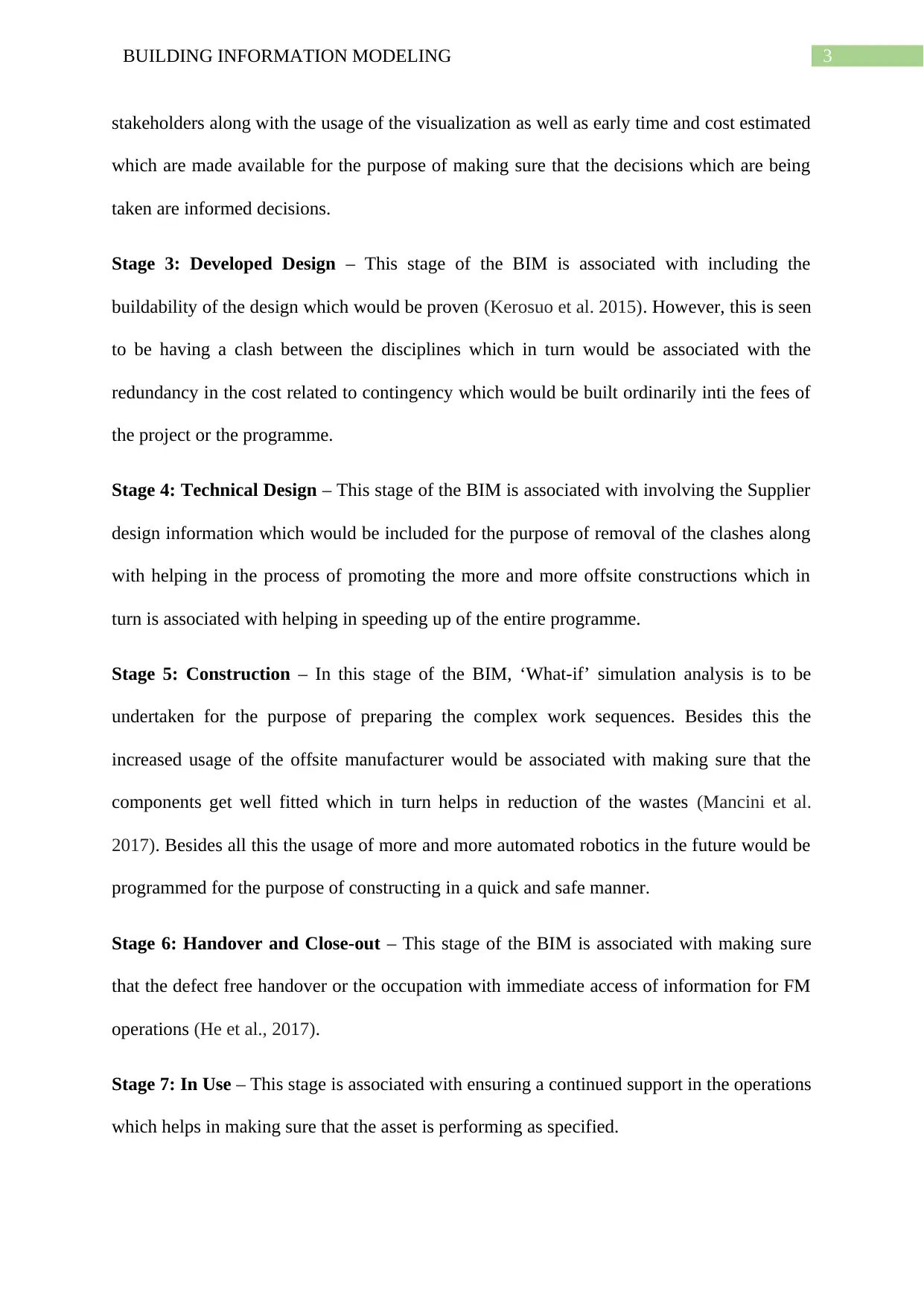
3BUILDING INFORMATION MODELING
stakeholders along with the usage of the visualization as well as early time and cost estimated
which are made available for the purpose of making sure that the decisions which are being
taken are informed decisions.
Stage 3: Developed Design – This stage of the BIM is associated with including the
buildability of the design which would be proven (Kerosuo et al. 2015). However, this is seen
to be having a clash between the disciplines which in turn would be associated with the
redundancy in the cost related to contingency which would be built ordinarily inti the fees of
the project or the programme.
Stage 4: Technical Design – This stage of the BIM is associated with involving the Supplier
design information which would be included for the purpose of removal of the clashes along
with helping in the process of promoting the more and more offsite constructions which in
turn is associated with helping in speeding up of the entire programme.
Stage 5: Construction – In this stage of the BIM, ‘What-if’ simulation analysis is to be
undertaken for the purpose of preparing the complex work sequences. Besides this the
increased usage of the offsite manufacturer would be associated with making sure that the
components get well fitted which in turn helps in reduction of the wastes (Mancini et al.
2017). Besides all this the usage of more and more automated robotics in the future would be
programmed for the purpose of constructing in a quick and safe manner.
Stage 6: Handover and Close-out – This stage of the BIM is associated with making sure
that the defect free handover or the occupation with immediate access of information for FM
operations (He et al., 2017).
Stage 7: In Use – This stage is associated with ensuring a continued support in the operations
which helps in making sure that the asset is performing as specified.
stakeholders along with the usage of the visualization as well as early time and cost estimated
which are made available for the purpose of making sure that the decisions which are being
taken are informed decisions.
Stage 3: Developed Design – This stage of the BIM is associated with including the
buildability of the design which would be proven (Kerosuo et al. 2015). However, this is seen
to be having a clash between the disciplines which in turn would be associated with the
redundancy in the cost related to contingency which would be built ordinarily inti the fees of
the project or the programme.
Stage 4: Technical Design – This stage of the BIM is associated with involving the Supplier
design information which would be included for the purpose of removal of the clashes along
with helping in the process of promoting the more and more offsite constructions which in
turn is associated with helping in speeding up of the entire programme.
Stage 5: Construction – In this stage of the BIM, ‘What-if’ simulation analysis is to be
undertaken for the purpose of preparing the complex work sequences. Besides this the
increased usage of the offsite manufacturer would be associated with making sure that the
components get well fitted which in turn helps in reduction of the wastes (Mancini et al.
2017). Besides all this the usage of more and more automated robotics in the future would be
programmed for the purpose of constructing in a quick and safe manner.
Stage 6: Handover and Close-out – This stage of the BIM is associated with making sure
that the defect free handover or the occupation with immediate access of information for FM
operations (He et al., 2017).
Stage 7: In Use – This stage is associated with ensuring a continued support in the operations
which helps in making sure that the asset is performing as specified.
⊘ This is a preview!⊘
Do you want full access?
Subscribe today to unlock all pages.

Trusted by 1+ million students worldwide
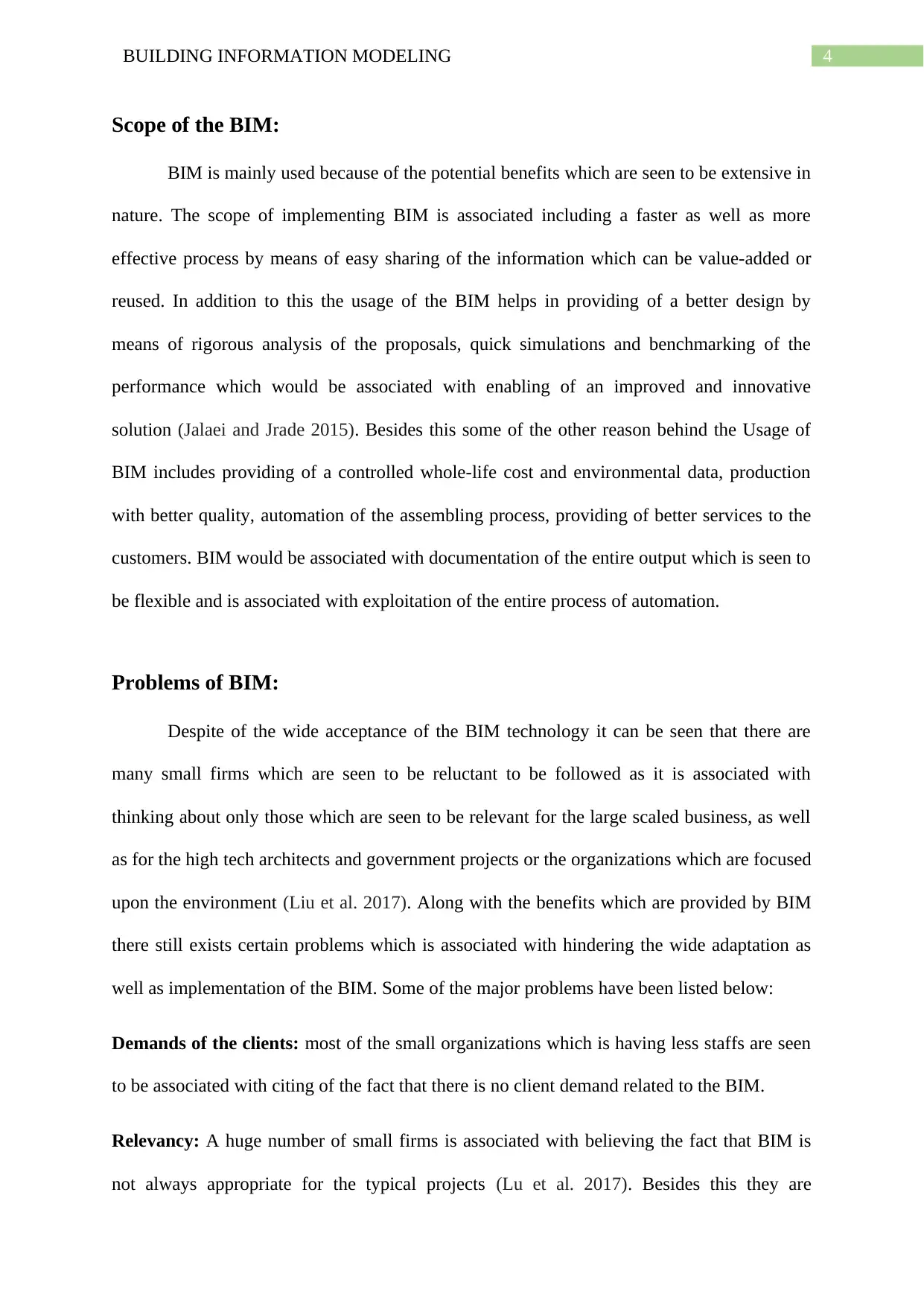
4BUILDING INFORMATION MODELING
Scope of the BIM:
BIM is mainly used because of the potential benefits which are seen to be extensive in
nature. The scope of implementing BIM is associated including a faster as well as more
effective process by means of easy sharing of the information which can be value-added or
reused. In addition to this the usage of the BIM helps in providing of a better design by
means of rigorous analysis of the proposals, quick simulations and benchmarking of the
performance which would be associated with enabling of an improved and innovative
solution (Jalaei and Jrade 2015). Besides this some of the other reason behind the Usage of
BIM includes providing of a controlled whole-life cost and environmental data, production
with better quality, automation of the assembling process, providing of better services to the
customers. BIM would be associated with documentation of the entire output which is seen to
be flexible and is associated with exploitation of the entire process of automation.
Problems of BIM:
Despite of the wide acceptance of the BIM technology it can be seen that there are
many small firms which are seen to be reluctant to be followed as it is associated with
thinking about only those which are seen to be relevant for the large scaled business, as well
as for the high tech architects and government projects or the organizations which are focused
upon the environment (Liu et al. 2017). Along with the benefits which are provided by BIM
there still exists certain problems which is associated with hindering the wide adaptation as
well as implementation of the BIM. Some of the major problems have been listed below:
Demands of the clients: most of the small organizations which is having less staffs are seen
to be associated with citing of the fact that there is no client demand related to the BIM.
Relevancy: A huge number of small firms is associated with believing the fact that BIM is
not always appropriate for the typical projects (Lu et al. 2017). Besides this they are
Scope of the BIM:
BIM is mainly used because of the potential benefits which are seen to be extensive in
nature. The scope of implementing BIM is associated including a faster as well as more
effective process by means of easy sharing of the information which can be value-added or
reused. In addition to this the usage of the BIM helps in providing of a better design by
means of rigorous analysis of the proposals, quick simulations and benchmarking of the
performance which would be associated with enabling of an improved and innovative
solution (Jalaei and Jrade 2015). Besides this some of the other reason behind the Usage of
BIM includes providing of a controlled whole-life cost and environmental data, production
with better quality, automation of the assembling process, providing of better services to the
customers. BIM would be associated with documentation of the entire output which is seen to
be flexible and is associated with exploitation of the entire process of automation.
Problems of BIM:
Despite of the wide acceptance of the BIM technology it can be seen that there are
many small firms which are seen to be reluctant to be followed as it is associated with
thinking about only those which are seen to be relevant for the large scaled business, as well
as for the high tech architects and government projects or the organizations which are focused
upon the environment (Liu et al. 2017). Along with the benefits which are provided by BIM
there still exists certain problems which is associated with hindering the wide adaptation as
well as implementation of the BIM. Some of the major problems have been listed below:
Demands of the clients: most of the small organizations which is having less staffs are seen
to be associated with citing of the fact that there is no client demand related to the BIM.
Relevancy: A huge number of small firms is associated with believing the fact that BIM is
not always appropriate for the typical projects (Lu et al. 2017). Besides this they are
Paraphrase This Document
Need a fresh take? Get an instant paraphrase of this document with our AI Paraphraser
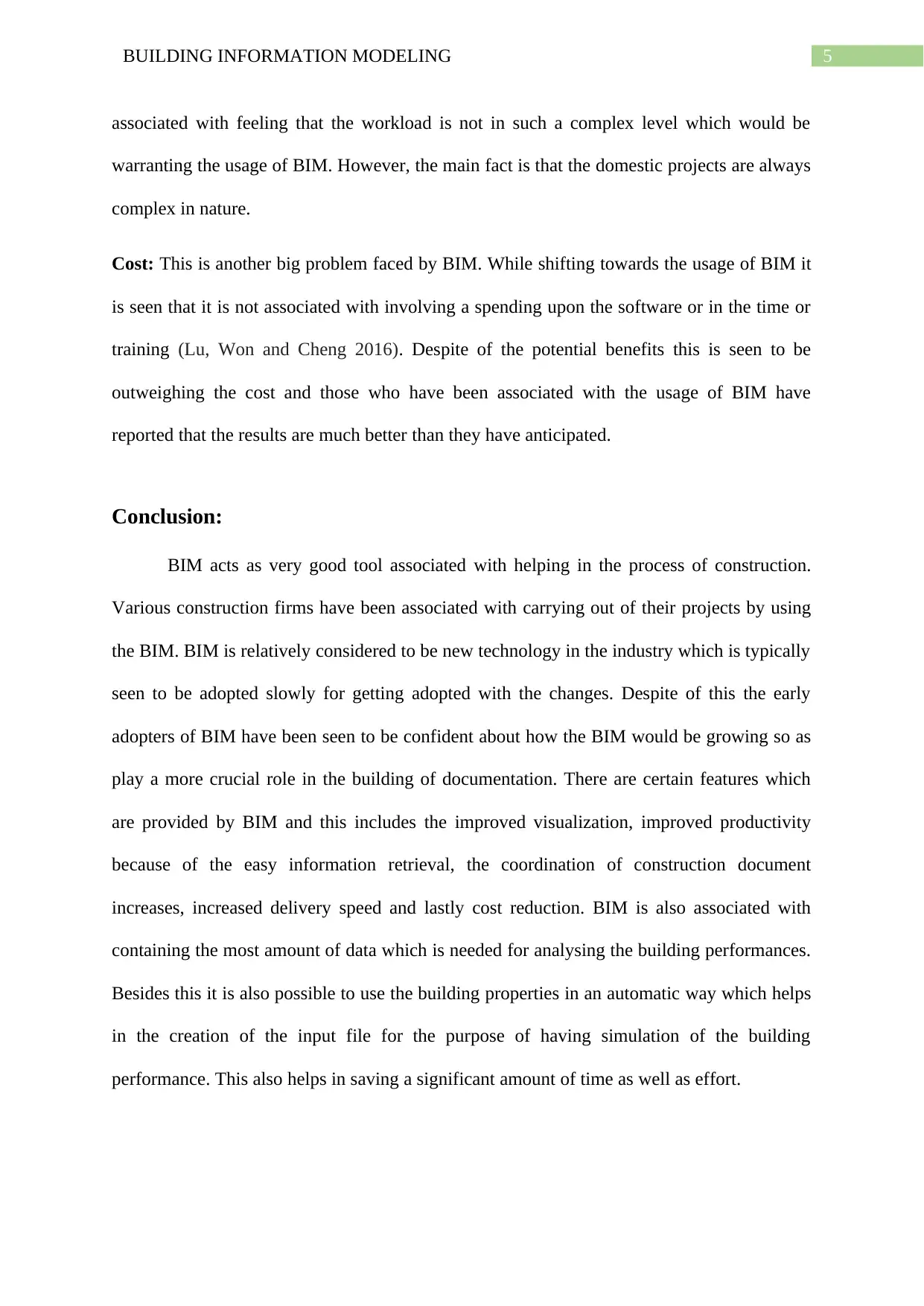
5BUILDING INFORMATION MODELING
associated with feeling that the workload is not in such a complex level which would be
warranting the usage of BIM. However, the main fact is that the domestic projects are always
complex in nature.
Cost: This is another big problem faced by BIM. While shifting towards the usage of BIM it
is seen that it is not associated with involving a spending upon the software or in the time or
training (Lu, Won and Cheng 2016). Despite of the potential benefits this is seen to be
outweighing the cost and those who have been associated with the usage of BIM have
reported that the results are much better than they have anticipated.
Conclusion:
BIM acts as very good tool associated with helping in the process of construction.
Various construction firms have been associated with carrying out of their projects by using
the BIM. BIM is relatively considered to be new technology in the industry which is typically
seen to be adopted slowly for getting adopted with the changes. Despite of this the early
adopters of BIM have been seen to be confident about how the BIM would be growing so as
play a more crucial role in the building of documentation. There are certain features which
are provided by BIM and this includes the improved visualization, improved productivity
because of the easy information retrieval, the coordination of construction document
increases, increased delivery speed and lastly cost reduction. BIM is also associated with
containing the most amount of data which is needed for analysing the building performances.
Besides this it is also possible to use the building properties in an automatic way which helps
in the creation of the input file for the purpose of having simulation of the building
performance. This also helps in saving a significant amount of time as well as effort.
associated with feeling that the workload is not in such a complex level which would be
warranting the usage of BIM. However, the main fact is that the domestic projects are always
complex in nature.
Cost: This is another big problem faced by BIM. While shifting towards the usage of BIM it
is seen that it is not associated with involving a spending upon the software or in the time or
training (Lu, Won and Cheng 2016). Despite of the potential benefits this is seen to be
outweighing the cost and those who have been associated with the usage of BIM have
reported that the results are much better than they have anticipated.
Conclusion:
BIM acts as very good tool associated with helping in the process of construction.
Various construction firms have been associated with carrying out of their projects by using
the BIM. BIM is relatively considered to be new technology in the industry which is typically
seen to be adopted slowly for getting adopted with the changes. Despite of this the early
adopters of BIM have been seen to be confident about how the BIM would be growing so as
play a more crucial role in the building of documentation. There are certain features which
are provided by BIM and this includes the improved visualization, improved productivity
because of the easy information retrieval, the coordination of construction document
increases, increased delivery speed and lastly cost reduction. BIM is also associated with
containing the most amount of data which is needed for analysing the building performances.
Besides this it is also possible to use the building properties in an automatic way which helps
in the creation of the input file for the purpose of having simulation of the building
performance. This also helps in saving a significant amount of time as well as effort.
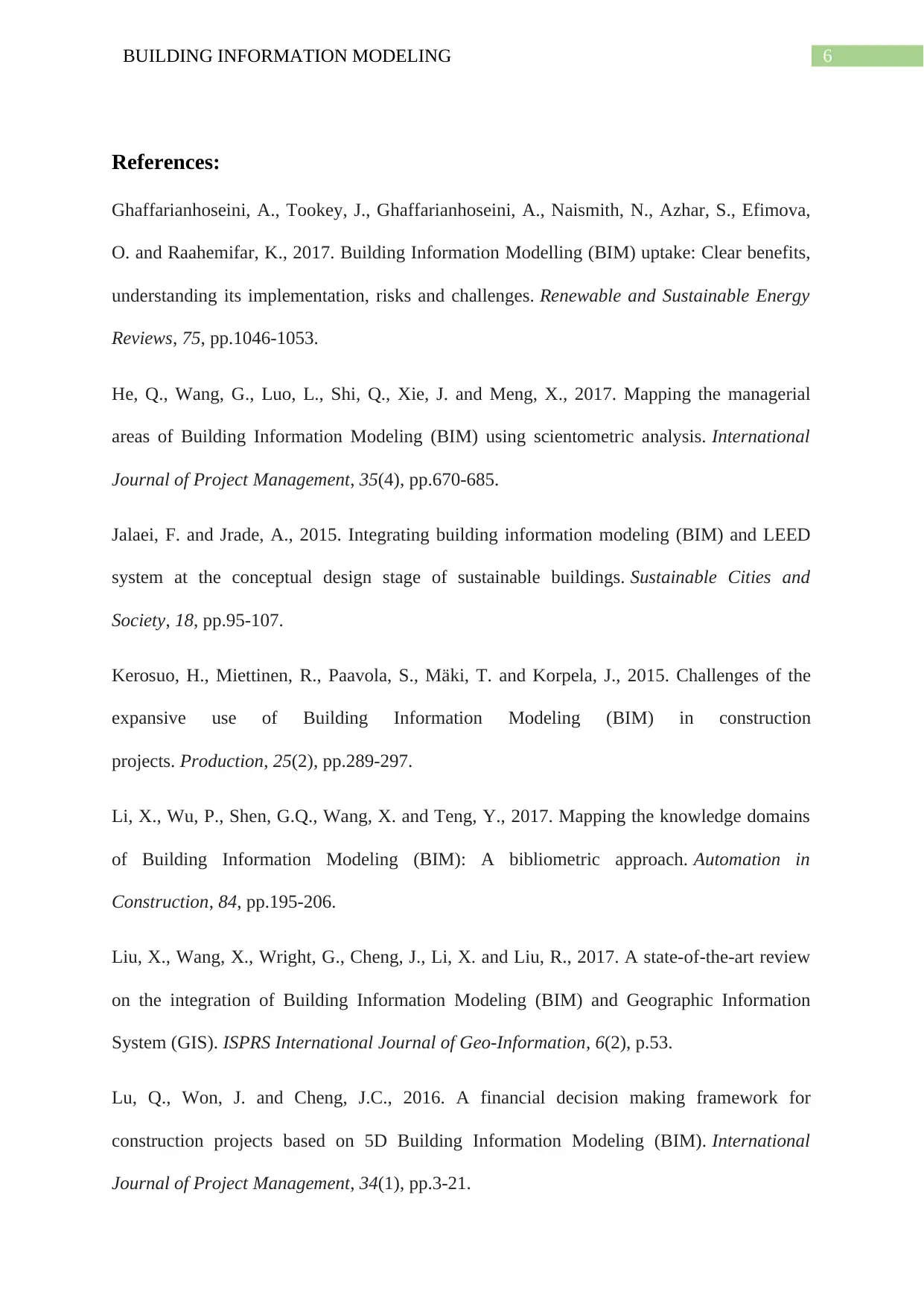
6BUILDING INFORMATION MODELING
References:
Ghaffarianhoseini, A., Tookey, J., Ghaffarianhoseini, A., Naismith, N., Azhar, S., Efimova,
O. and Raahemifar, K., 2017. Building Information Modelling (BIM) uptake: Clear benefits,
understanding its implementation, risks and challenges. Renewable and Sustainable Energy
Reviews, 75, pp.1046-1053.
He, Q., Wang, G., Luo, L., Shi, Q., Xie, J. and Meng, X., 2017. Mapping the managerial
areas of Building Information Modeling (BIM) using scientometric analysis. International
Journal of Project Management, 35(4), pp.670-685.
Jalaei, F. and Jrade, A., 2015. Integrating building information modeling (BIM) and LEED
system at the conceptual design stage of sustainable buildings. Sustainable Cities and
Society, 18, pp.95-107.
Kerosuo, H., Miettinen, R., Paavola, S., Mäki, T. and Korpela, J., 2015. Challenges of the
expansive use of Building Information Modeling (BIM) in construction
projects. Production, 25(2), pp.289-297.
Li, X., Wu, P., Shen, G.Q., Wang, X. and Teng, Y., 2017. Mapping the knowledge domains
of Building Information Modeling (BIM): A bibliometric approach. Automation in
Construction, 84, pp.195-206.
Liu, X., Wang, X., Wright, G., Cheng, J., Li, X. and Liu, R., 2017. A state-of-the-art review
on the integration of Building Information Modeling (BIM) and Geographic Information
System (GIS). ISPRS International Journal of Geo-Information, 6(2), p.53.
Lu, Q., Won, J. and Cheng, J.C., 2016. A financial decision making framework for
construction projects based on 5D Building Information Modeling (BIM). International
Journal of Project Management, 34(1), pp.3-21.
References:
Ghaffarianhoseini, A., Tookey, J., Ghaffarianhoseini, A., Naismith, N., Azhar, S., Efimova,
O. and Raahemifar, K., 2017. Building Information Modelling (BIM) uptake: Clear benefits,
understanding its implementation, risks and challenges. Renewable and Sustainable Energy
Reviews, 75, pp.1046-1053.
He, Q., Wang, G., Luo, L., Shi, Q., Xie, J. and Meng, X., 2017. Mapping the managerial
areas of Building Information Modeling (BIM) using scientometric analysis. International
Journal of Project Management, 35(4), pp.670-685.
Jalaei, F. and Jrade, A., 2015. Integrating building information modeling (BIM) and LEED
system at the conceptual design stage of sustainable buildings. Sustainable Cities and
Society, 18, pp.95-107.
Kerosuo, H., Miettinen, R., Paavola, S., Mäki, T. and Korpela, J., 2015. Challenges of the
expansive use of Building Information Modeling (BIM) in construction
projects. Production, 25(2), pp.289-297.
Li, X., Wu, P., Shen, G.Q., Wang, X. and Teng, Y., 2017. Mapping the knowledge domains
of Building Information Modeling (BIM): A bibliometric approach. Automation in
Construction, 84, pp.195-206.
Liu, X., Wang, X., Wright, G., Cheng, J., Li, X. and Liu, R., 2017. A state-of-the-art review
on the integration of Building Information Modeling (BIM) and Geographic Information
System (GIS). ISPRS International Journal of Geo-Information, 6(2), p.53.
Lu, Q., Won, J. and Cheng, J.C., 2016. A financial decision making framework for
construction projects based on 5D Building Information Modeling (BIM). International
Journal of Project Management, 34(1), pp.3-21.
⊘ This is a preview!⊘
Do you want full access?
Subscribe today to unlock all pages.

Trusted by 1+ million students worldwide
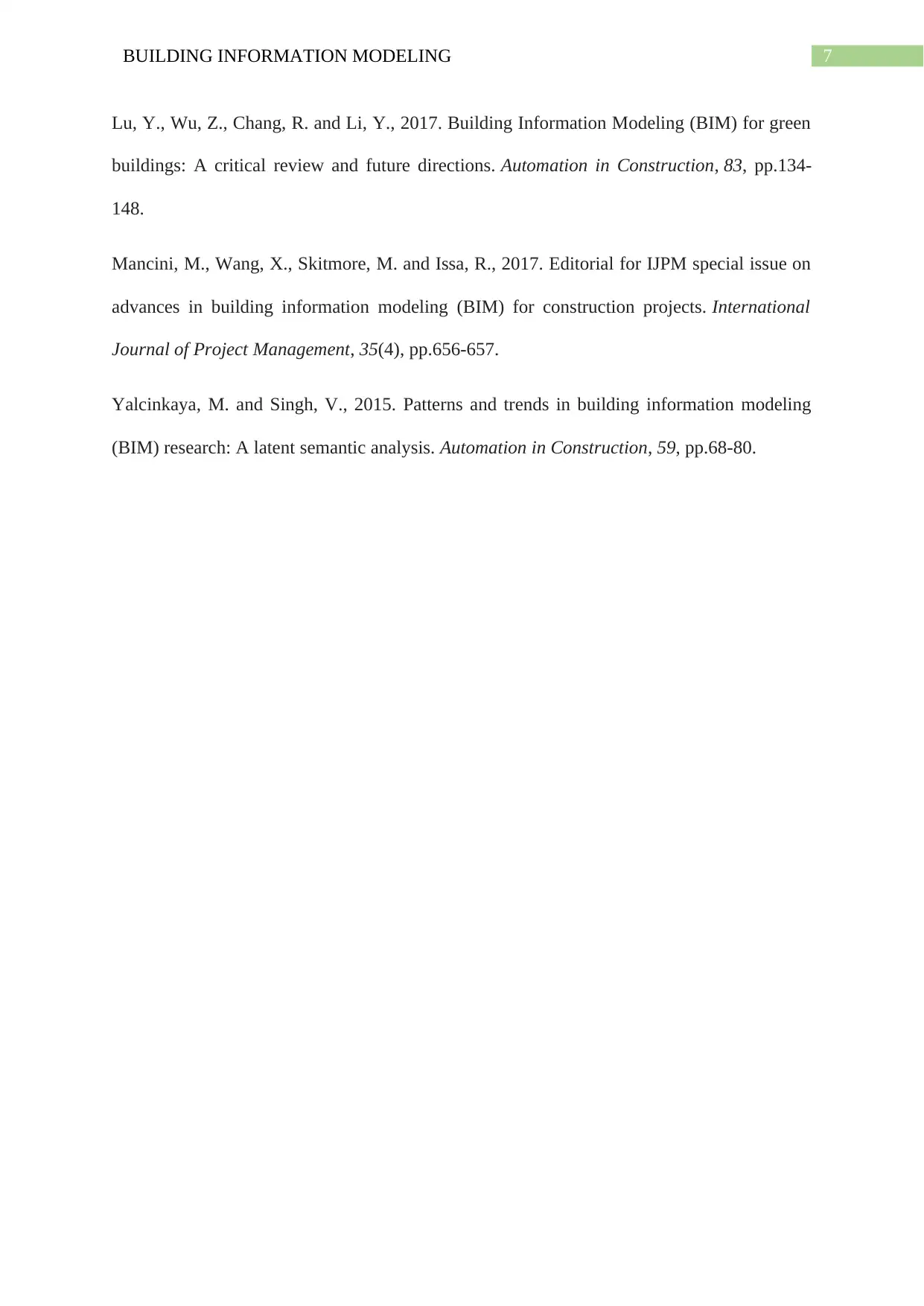
7BUILDING INFORMATION MODELING
Lu, Y., Wu, Z., Chang, R. and Li, Y., 2017. Building Information Modeling (BIM) for green
buildings: A critical review and future directions. Automation in Construction, 83, pp.134-
148.
Mancini, M., Wang, X., Skitmore, M. and Issa, R., 2017. Editorial for IJPM special issue on
advances in building information modeling (BIM) for construction projects. International
Journal of Project Management, 35(4), pp.656-657.
Yalcinkaya, M. and Singh, V., 2015. Patterns and trends in building information modeling
(BIM) research: A latent semantic analysis. Automation in Construction, 59, pp.68-80.
Lu, Y., Wu, Z., Chang, R. and Li, Y., 2017. Building Information Modeling (BIM) for green
buildings: A critical review and future directions. Automation in Construction, 83, pp.134-
148.
Mancini, M., Wang, X., Skitmore, M. and Issa, R., 2017. Editorial for IJPM special issue on
advances in building information modeling (BIM) for construction projects. International
Journal of Project Management, 35(4), pp.656-657.
Yalcinkaya, M. and Singh, V., 2015. Patterns and trends in building information modeling
(BIM) research: A latent semantic analysis. Automation in Construction, 59, pp.68-80.
1 out of 7
Related Documents
Your All-in-One AI-Powered Toolkit for Academic Success.
+13062052269
info@desklib.com
Available 24*7 on WhatsApp / Email
![[object Object]](/_next/static/media/star-bottom.7253800d.svg)
Unlock your academic potential
Copyright © 2020–2025 A2Z Services. All Rights Reserved. Developed and managed by ZUCOL.




